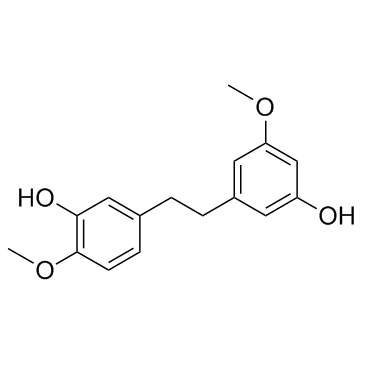| Description |
Gigantol is a bibenzyl compound derived from several medicinal orchids. Giganto shows promising therapeutic potential against cancer cells. Gigantol is a novel inhibitor of the Wnt/β-catenin pathway.
|
| Related Catalog |
|
| Target |
Wnt[1]
|
| In Vitro |
Gigantol decreases the level of phosphorylated LRP6 and cytosolic β-catenin in HEK293 cells. In breast cancer MDA-MB-231 and MDA-MB-468 cells, treatment with gigantol reduces the level of phosphorylated LRP6[1]. Gigantol significantly inhibits the proliferation and induces apoptosis of the HepG2 cells. Gigantol at concentrations of 1, 40 and 150 µM markedly decreases the cell viability by 11.7, 30.0 and 56.4% at 24 h and 21.1, 66.8 and 85.5% at 48 h, respectively. The IC50 value is 9.30 µM[2].
|
| In Vivo |
LDD and gigantol (25–100 mg/kg, p.o.) significantly increase the hot-plate latency in comparison to vehicle-treated mice and decreased carrageenaninduced inflammation in rats[2].
|
| Cell Assay |
HepG2 cells are treated with a series of concentrations of Gigantol (1, 10, 40, 80 and 150 µM) for different time intervals (12, 24 and 48 h). The cytotoxicity is measured using MTT assays[2].
|
| Animal Admin |
Rats[3] The anti-inflammatory activity is determined by carrageenan-induced edema test in the hind paws of rats. Sprague-Dawley rats are fasted for 15 h before the experiment with free access to water. One hundred microlitres of 1% carrageenan (10 mg/mL, Type IV, lambda) suspension is prepared 30 min before each experiment and injected into the plantar side of right hindpaw of the rats. The CH2Cl2-MeOH Scaphyglottis livida and Maxillaria densa extracts (150-600 mg/kg), as well as compound LDD and gigantol (25-100 mg/kg), are orally administered. The extracts, LDD and gigantol are administered 1 h before the carrageenan treatment[3]. Mice[3] Mice receive an oral administration of vehicle (0.2% Tween-80) or increasing doses of Scaphyglottis livida and Maxillaria densa extracts (150–600 mg/kg) or LDD and gigantol (25-100 mg/kg) 30 min before the thermal noxious stimuli in the hot-plate test. Morphine (1.5-6 mg/kg, p.o.) is used as positive control. Mice are observed before and at 30, 60, 90 and 120 min after drugs administration[3].
|
| References |
[1]. Yu S, et al. Gigantol inhibits Wnt/β-catenin signaling and exhibits anticancer activity in breast cancer cells. BMC Complement Altern Med. 2018 Feb 14;18(1):59. [2]. Chen H, et al. Gigantol attenuates the proliferation of human liver cancer HepG2 cells through the PI3K/Akt/NF-κB signaling pathway. Oncol Rep. 2017 Feb;37(2):865-870. [3]. Déciga-Campos M, et al. Antinociceptive and anti-inflammatory effects of compounds isolated from Scaphyglottis livida and Maxillaria densa. J Ethnopharmacol. 2007 Nov 1;114(2):161-8.
|


